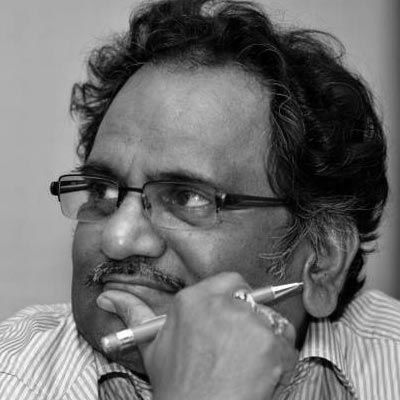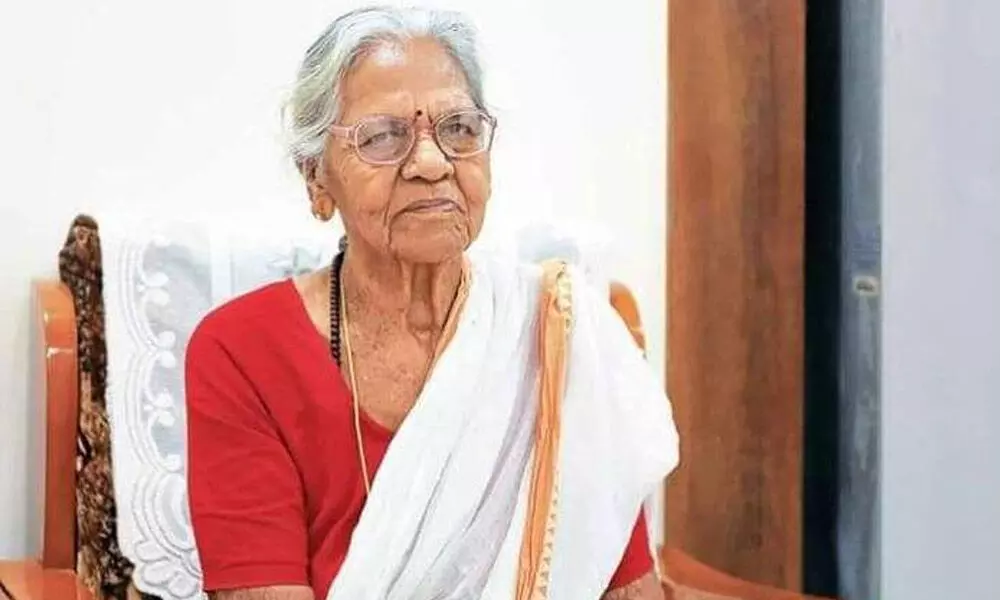Live
- BJP hijacked electoral machinery for securing victory in Maharashtra: Cong
- Formula 1: Russell pips Sainz to take pole in Las Vegas GP
- People voted for ideology, rejected dynasty: Sudhanshu Trivedi on Maha victory
- AP, Telangana to receive rains for next three days as low pressure to turn depression
- Kailash Gahlot inducted into BJP’s Delhi election panel
- With state elections over, Indian stock market heads for stability
- Mahayuti's Ladki Bahin Brahmastra demolishes MVA in Maharashtra
- Actor and Youth Ambassador Darasing Khurana Highlights Mental Health Issues with Singapore PM
- Heavy FII selling in India to taper off soon, say market watchers
- Esports Mania Grips India: What are the Trends Fueling this Growth?
Just In
At 11 she saw exploitation; at 16 picked up the gun


At 11 she saw exploitation; at 16 picked up the gun
Her father wanted to name her Samrajyam in praise of British dynasty.
Her father wanted to name her Samrajyam in praise of British dynasty. Her mother Chokkamma thought in her own away, and gave an independent name- 'Swarajyam,' (the self-rule). Those were the days of freedom struggle around and armed struggle by peasants in Telangana (Hyderabad State). Chokkamma guided her and inspired her life. As she was rightly named, she stood for Swarajyam and Swatantryam (self-choice). She is Mallu Swarajyam. Mallu means skilful at kusthee, physical fight.
"Pattisthe Padivelu (= catch her and take Rs 10,000)." Nizam fixed Rs 10 thousand on her head. It was a huge money, and sure way of getting the revolutionary caught as people mostly are greedy, selfish and irresponsible. But she was never caught. People knew her sacrifices and struggle against the cruel regime.
Mallu Swarajyam, a name to reckon with, is a soldier of armed peasant struggle of Telangana. She is an unforgettable personality, a hero, and warrior; a nightmare for Nizam and his subordinate Doras who exploited the poor. She is a fiery speaker. Her 'Maatalu (words)' were 'thootalu', bullets.
Dunnevadide Bhoomi ( land belongs to the tiller), Geese Vanikey Chettu ( taddy tappers own those trees), Bhoomi Kosam Bhukthi Kosam Prajaswamya Vimukti Kosam Ee poratam ( this struggle is to free our land, food, and for the liberal democracy). These are the slogans, she used like mantras and wake up calls.
Though born in semi-feudal family, she was not feudal. Her family also was very generous. They gave up around 600 acres of land to the poor. She saw her family members were helping the poor and doing something for their betterment. Swarajyam had culture of social commitment. Their compassion for the poor made her a human being with concern for fellow beings. At 13 she was thinking about poor and their development, in the footsteps of the co-members of the family. At 16, she picked up gun.
She motivated youth to take to arms to struggle to get ready to be killed and to kill. Whenever she was asked about the glory of revolutionary days, she tried to speak ferociously, though age did not cooperate. When asked her to be normal, she used to say, 'no, the story of revolution requires that speed and volume.' That is her spirit.
Her gender never came in the way of her movement. She made several young men and women take up to guns against exploiting regime of Nizam. Those were the days in 1945-46. The innocent farmers were turned revolutionaries questioning slavery.
While entire India was fighting the British, the Telangana farmers were facing the cruel Nizam. Hyderabad State was under the inhuman rulers and feudal lords. Dora used to simply grab the land of a poor farmer and got it mixed up with huge tract of agricultural fields, besides turning the owners of small pieces of land into his coolies. The coolie would not even get the money for it.
Nizam is such an exploiter that there were various kinds of taxes on almost everything. If somebody is born, that family has to pay nazarana. The marriage in home also a source of tax for the nawab. Every artisan, merchant or small-time artiste, has to pay a portion of his income. The mothers were made to work within three days of giving birth to baby. They were also not allowed to feed crying babies. Some died of starvation. But that does not move the dora or zamindar. They cannot wear chappal before the Gadi of dora, even if gates are closed or Gadi is locked. Nee banchon, Dora nee kaal moktha, (=I am your slave, dora I will touch your feet) is the prefix for anybody to anything to Dora or his agent. One has to remove his rumaal, headgear and place it on dora's feet.
Dora used to have private army who are none but goondas, they spread tyranny, kill men, rape women, burn the houses or remove the crops. Whether you fight or not, you will be killed, raped or exploited. If that is the case, why not we get ready to be killed and kill as many as possible? This was the inspiration for Mallu Swarajyam. 'Slavery no more, dying in fear no more, let us fight to kill the evil forces, we die anyway. Why fear?' These were her bullets through mikes.
Her mother Chokkamma gave her the book 'Mother' of Maxim Gorky. The 'mother' in it moved her the most. The character of old woman took up the cause of her son, who was arrested for leading communist movement in Russia. That theme, story and ideas made her a warrior, and shaped her as a communist. She built and took active part in the revolution. She was also influenced by her brother, a famous fighter, Bhimreddy Narasimha Reddy, and his classmate Raavi Narayan Reddy. She learnt the courage to question the system, break and rebuild it.
Razaakars were looting the village after the village. The residents of the village should get ready to face these dacoits coming in group with arms. Mallu Swarajyam's duty was to team villagers up, inspire and motivate to face the crisis. Every village should have a dalam to defend and assault the Razaakars. She organized 20 to 30 dalams in villages.
Another task Mallu performed was to build and establish Libraries to educate the rural folk. She used to collect men and women under a tree to educate them. On their own people formed panchayats under Mallu's guidance. Now the people can throw stones through vadiselu, a spring like rope arrangement to throw stones at enemy. They used to fill the mirchi water in pipes and spray them into the eyes of the Razakaars and Nizam's military. This struggle gradually grew into an armed struggle of farmers.
She was trained by an ex-army personality Major Jaipal Singh in using the gun, and became one of 300 women who have learnt to hold and fire the guns, strategize the combat, fight the enemy by striking at them. Swarajyam recalled how her cousin was fighting Nizam's police, and was dying because the enemy overpowered him. At that time, he was focusing on destroying his gun as he never wanted the enemy to use the gun against his fellowmen. That is the commitment of the fighters. She lost four of her cousins in the fight. She counted that the fight was to liberate thousands of villages from the intermittent attacks by the Nizams Military and private militia -Razakars. Thousands died to save thousands of villages. She said that at least four thousand of her colleagues laid down their lives for liberating their villages and 3000 villages were freed from terror of Razakars.
Andhra Mahasabha was vociferous against the forced bonded labour and irrational taxing policy under the Nizam. They used to confiscate lands in lieu of dues of taxes and drive the owners out of their own lands, take away the residential houses and throw out the owners, with their cloths and utensils. Doddi Komuraiah from Kadivendi village of Nalgonda District, who emerged from Andhra Mahasabha as a hero of armed struggle, was killed by Visunur Ramachandra Reddy, a cruel Deshmukh. Komuraiah's death sent across a strong message for fighting the feudal lords. The movement spread into other districts like Warangal, Nalgonda, Karimnagar and Adilabad.
But it is a tragedy that this great fighter has to continue her fight even after overthrowing Nizam, killing Visnuru Dora, chasing Razakars out and defeating Nizam's military to liberate Hyderabad, as the plight of farmers remained the same, lands went back to landlords, poor became poorer. Fight for land became endless fight.
She narrated an incident. In 1978 and 1983 she was elected to Assembly. One farmer went to her crying and told that a dora took away his land forcefully. She went there with a group of people to negotiate with Dora. But the Dora started firing bullets at them. The group defended by pelting stones, which were their weapons at that time. Mallu Swarajyam collected those bullets fell on ground and presented them in Assembly. She asked the legislative assembly. "Is this the democracy we fought for?"
Every voter has a duty to answer this question.
(She lived up to 91 years and breathed her last in Hyderabad on March 19, 2022)
(The author is Dean & Professor, School of Law, Mahindra University, Hyderabad, and former Central Information Commissioner) (The opinions expressed in this column are those of the writer. The facts and opinions expressed here do not reflect the views of The Hans India)Madabhushi Sridhar Acharyulu

© 2024 Hyderabad Media House Limited/The Hans India. All rights reserved. Powered by hocalwire.com






